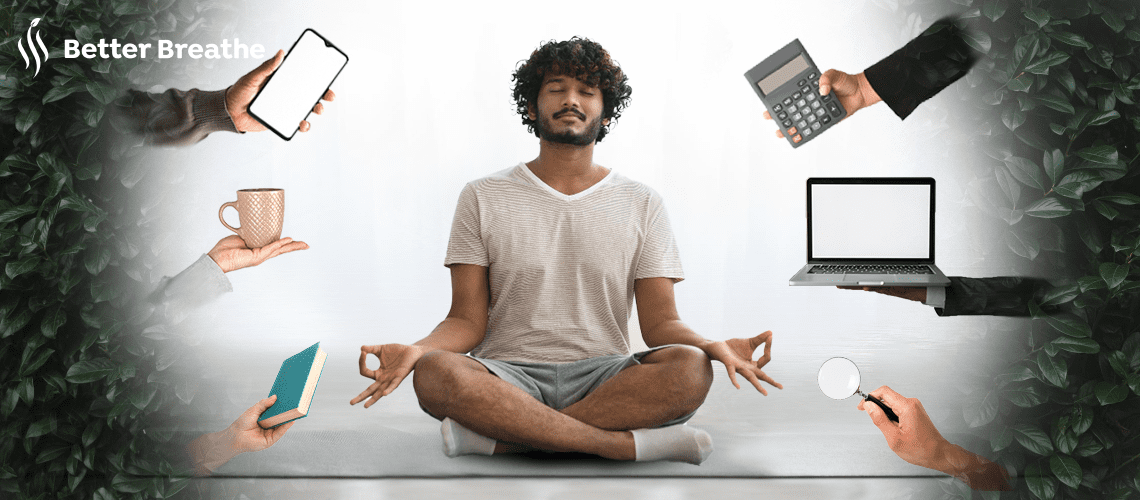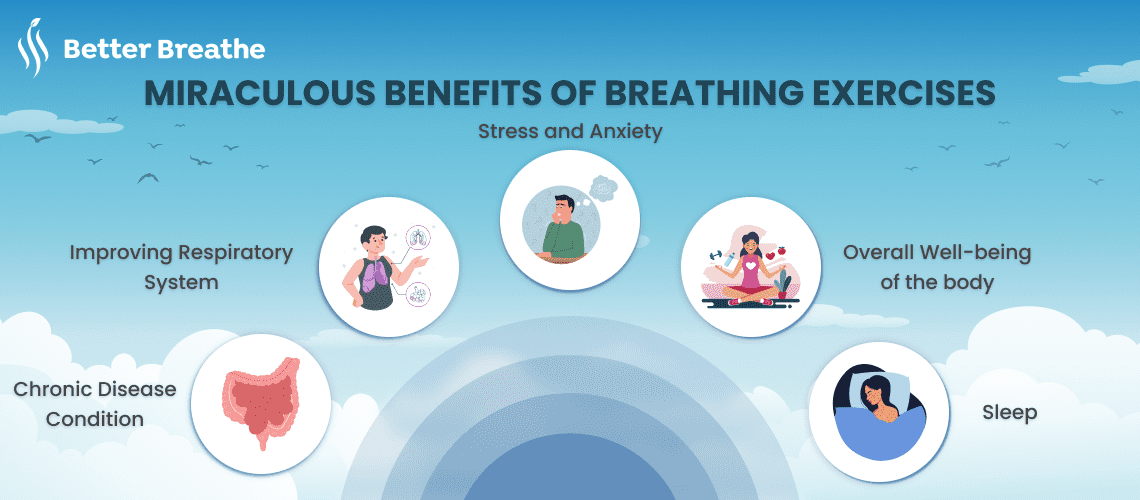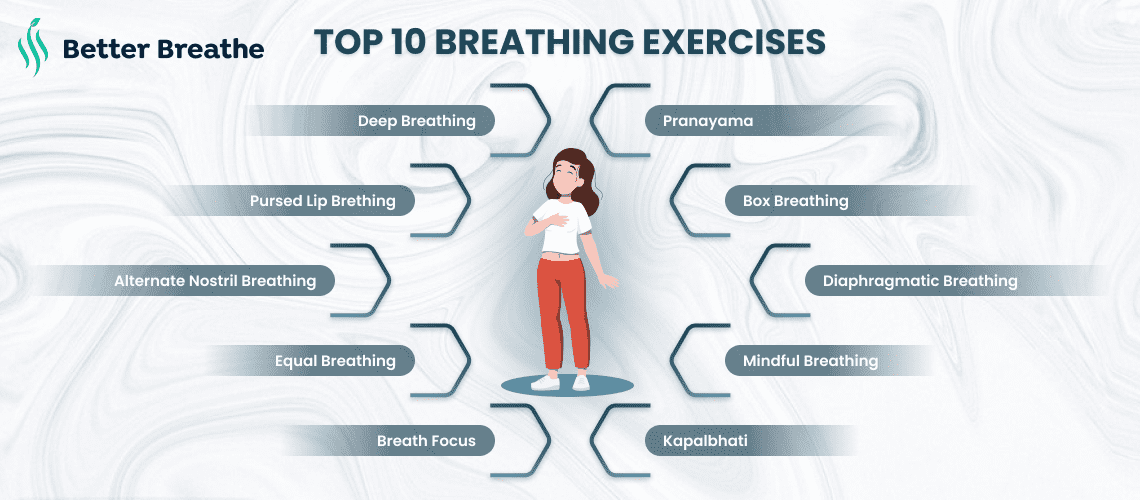Blog
Blog Details
Find Out 10 Breathing Exercises Before a Visit to a Health Expert
Apr 13, 2024
4 min read

Deep breathing is a simple yet effective way to move into a centered state, reduce stress, and promote relaxation before a medical appointment. Focusing on your breath can help you calm your nerves, clear your mind, and approach your visit confidently and clearly.
Our guide explores ten breathing exercises you can practice before seeing a health expert. These exercises, including deep belly breathing and meditation-based calming techniques, aim to help you cultivate a sense of calm and presence during your visit with your healthcare provider. Incorporating these breathing exercises into your pre-appointment routine can be beneficial whether you want to address physical symptoms or discuss your overall health.
Breathing exercises benefit both body and mind, making them a valuable tool for promoting overall health. Exercises that use breath to promote profound physiological and psychological changes range from ancient practices like yoga and meditation to more recent techniques developed for stress management.
There are some amazing benefits of Breathing Exercises. When people say it has miraculous effects, they aren’t lying because breathing in a flow and focusing solely on breathing can create miraculous benefits. Let’s have a look at a few advantages of breathing.

The respiratory system includes the lungs and diaphragm, and continuously practicing breathing exercises will help improve and strengthen the respiratory system in the long term.
Health issues like asthma, COPD, insomnia, high blood pressure, and other respiratory conditions can be fought by regular breathing exercises.
Stress and anxiety are very common and are faced by millennials and younger generations due to study pressure, workload, and everything else. Breathing in a rhythm will help in releasing all the negative energy, focus, and accepting the feeling, which will help in healing mentally.
Work pressure and anxiety often prevent proper sleep, which can eventually turn into serious issues like insomnia. Breathing exercises will help reduce anxiety and give a feeling of calmness in the mind and body, hence improving sleep quality.
Practicing breathing exercises will show a gradual improvement in health, mental clarity, and leading a stress-free life. Overall, not only will breathing exercises help you in fighting chronic disease conditions, but they also provide a sense of calm in your busy routine.

There are a lot of breathing exercises, but as a beginner, it is advisable to start with easy ones and progress to simple ones once you start getting the hang of them. Here are the 10 breathing exercises that you should start with for a better lifestyle.
It is all about breathing through the nose, inhaling and exhaling while focusing on the contraction and relaxation of the diaphragm. This particular exercise of the contract and relax mechanism will improve lung strength and overall strengthening of the respiratory system.
This is one of the very common terms used in breathing. Whenever you feel shortness of breath or anxiety, come aside and take deep breaths which involve inhaling deeply and exhaling deeply. It creates a sense of calmness and helps you feel relaxed in a pressurized environment. If you are a student feeling nervous before an exam or before going for an interview, deep breaths are always helpful.
One of the most commonly practiced breathing exercises while meditating is this. We just have to breathe in and breathe out slowly, focusing on the thoughts coming into the mind and releasing the negative thoughts, letting go of things we feel are unnecessary. This will bring a drastic change in life if practiced continuously.
This is a breathing technique in which you exhale with pursed lips and inhale from the nose while the mouth is closed. This technique is useful in conditions like respiratory problems and COPD.
This exercise helps in balancing the nervous system and also reduces anxiety. It involves breathing alternately while closing the left nostril and breathing in from the open one and vice versa.
Pranayama is a yogic breathing exercise that is widely followed and recommended by medical professionals. In other terms, it is also known as breath control. It is done not only for physical well-being but also for spiritual well-being.
This is an interesting technique where we count to four, inhale, and then count to four to exhale. In the next count to four, we hold our breaths. This is a beautiful technique to release stress and feel calm.
As the name suggests, this breathing exercise is about exhaling and inhaling within a specific time, like 2 seconds. This helps in focusing on the present and maintaining a sense of calmness.
This is one of the most simple and effective breathing exercises. It allows you to focus on the present thoughts and all the thoughts in mind, helping to deal with them effectively. It allows you to breathe, focus on the thoughts, breathe the tension out, and release the tension. This helps to overcome stress, nervousness, and anxiety, and induces calmness.
The most famous yogic breath control exercise that improves digestion and the digestive system. In Kapalbhati, forceful exhalations and passive inhalations are performed. Include this in your daily yoga session after performing the pranayama and feel the change happening.
These exercises are all very effective even if you are a beginner to breathing exercises. If you are pregnant or a lactating mother, it is always advisable to try breathing exercises with the consultation of a doctor as it will prove to be beneficial for the mother and baby’s health too. Having these exercises in your daily routine will help in creating stability in life and promote overall well-being. With Better Breath, available for download on the Play Store and App Store, users can access premium features including personalized guidance, advanced breathing exercises, and progress tracking. Start your journey towards better health and well-being today with Better Breath.